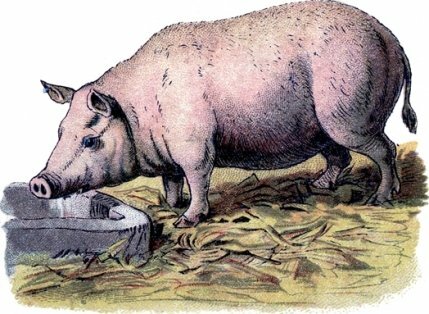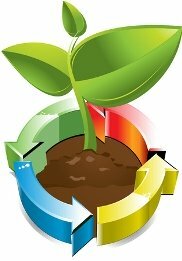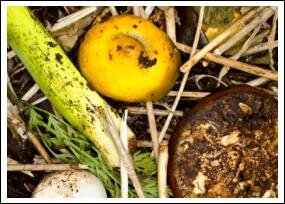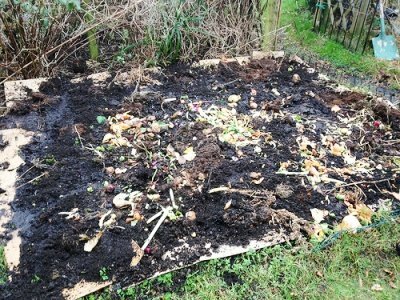Lasagna Gardening
Have you heard the office buzz saying, Let's hit the ground running? That's what the scraps do as they're tossed onto a Lasagna pile. It's a great heap of pig's breakfast muck, all thrown on top of each other and provides a perfect place for nature to break it all down and grow, GROW, GROW jack-in-the-beanstalks, or similar, well nearly!

Seriously, lasagna gardening, sometimes called sheet composting or layer gardening — is another practical and natural short cut to digging and tilling, and follows similar guidelines as other no-dig methods.
You know those barren, sloped, stony, weedy, sandy or clay compacted places where you look at aghast and wonder how you could ever get a garden going there? That's where lasagna gardening proves its worth.
Just toss down layer upon layer. That's what a lasagna garden is — layers.
The layers are not so planned as a no-dig raised bed garden, where the compost is pre-made and added.
How to Build a Lasagna Garden
With lasagna gardening it is done by sheet composting whereby the scraps and weeds and old boots if you like are all dumped in one spot... well, layered on top of each other.

It's all recycled in one spot... and boy oh boy does it work!
Start with whatever materials you have; maybe old leaves, then 5-10 layers of newspaper, or some thick cardboard, next a bucket of kitchen scraps, seaweed, some grass clippings, then straw. Soak it well with water.
OR... start with cardboard, then old grass, straw, old horse or chicken manure, some soil or compost, then coffee grounds, more grass, prunings, fruit peelings, veggie scraps, wood chips, seaweed... just keep piling it on.
Honestly you can do any topsy-turvy way you like with whatever organic material is at hand. It will eventually all rot and provide a great home for your plants.
Obviously there are tried and true materials and the order they are layered, that speed up the process. It does help of course to alternate layers of carbon (brown, drier material) with nitrogen (green, living material) which provides a balanced state of aeration and moisture.

What it really rots down to is that lasagna gardening is just like other no-dig methods, whether done by gardeners, or in the wild...
Layers of whatever nature happens to whirl around in the environment then drop on the ground, covered with something from a passing animal.
Then some leaves fluttering down, a dead branch or two, and soon the worms and crawlies find a home there.
A few seeds decide to set up home and grow, and so the cycle continues.
With lasagna gardening — as with all no-dig methods, using newspaper or cardboard, or your old school reports if you want to, suppresses any greenery underneath and decomposes well. Equally important, earthworms love paper and stampede towards it, nicely aerating the soil.
When to Plant with Lasagna Gardening
Build up your layers of sheet composting to roughly 60cm (2ft) then watch as earthworms and microbes get to work... and within a few months your lasagna garden will look like a normal garden.
It may take a year for all material to break down completely and you can top up with a layer of scraps or suchlike and mulch any time.

Plantings can be done immediately, but remember it will settle quickly to a lower level, and for small plants there will not be much nutrients released from the material until decomposition occurs.
To plant seedlings and seeds in your layer garden, use some compost or potting mix.
For shrubs, or any plants that need some soil around their roots, you will need to dig a hole and put some compost in first.
Making a lasagna garden can be done at the end of summer and left over winter ready for planting in spring. If made in spring, add compost or good soil so that the plants have something to get their teeth into for growing to begin with.
Sheet Composting Gardening the Lasagna Way — A couple of Ideas
Here's what has worked for me, and I can tell you it's more than one way! I have successfully tried:
- Layers of old wool carpet, rotten floorboards, mushy kitchen scraps slopped straight onto the pile, tangled weeds and grass, sprinkle of lime, wet newspapers, topped with piles of fallen leaves and grass clippings... then planted seedlings in with small handfuls of soil or compost.
- Bulldozed pile of cleared backyard mess (just moved there) with mostly branches, giant weeds, even old washing machine parts, and the odd cannabis plant... planted zucchini and pumpkin plants each in a good dollop of compost in the pile... and watched as the pile shrunk and the zucchini and pumpkins took off!
So you can see the lasagna gardening method is ideal if you are renovating or have recently moved and need to 'tidy' up the place.
The various other raised bed or organic gardening methods are all described here:
No Till Gardening
Straw Bale Gardening
Sq ft Gardening
Raised Vegetable Garden
